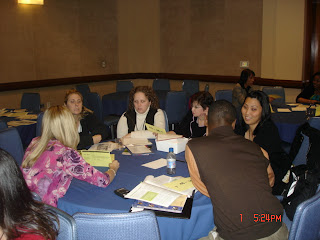 Autism Orlando
Autism OrlandoBiennial Conference, 2008
“Autism Through the Lifespan”
Although I spent four years working with autistic children in Tampa eighteen years ago and have had a few children with PDD, autism and Asperger’s Syndrome through the subsequent years, I have wanted to look at the most up-to-date research as I am including FOUR children on the autism spectrum in a regular Kindergarten classroom this year. I have been looking for conferences and reading material that might make a difference for these children. This weekend, I was able to attend an Autism Conference in Orlando, FL through EP LiveOnline Webcasting in the comfort of my own home, saving a substantial amount of money and time for this professional development in a new format. This conference is billed as “22 of the leading autism experts in the biochemical, behavioral and developmental world.”
About the content
This conference definitely presented the biomedical interventions that are now available for children on the autism spectrum. They stressed again and again, that they will not all work with every child and that parents must be persistent and discerning about which treatment(s) are appropriate for their child. The conference was peppered with “recovery” videos and recovered speakers (including Raun Kaufman and Elijah Wapner). The videos and personal testimonies certainly offer hope. This is good background for me as parents question and make decisions about their particular child's program.
Below are just a few of the therapy options available to parents today. Some of these are outside of education, but need to be understood as education partners with the family for the best outcome for each individual child.
- Detoxification/ Chelation therapy
- Hyperbaric Oxygen therapy
- Antiviral and Nasal Methyl B12 Spray therapies
- Behavioral therapy
- Dietary interventions
- Digestive/ gastrointestinal interventions
- Melatonin replacement
Possible autism causes:
- Genetic and Metabolic (that you can’t really do anything about)
- Fungus/ Bacterial
- Viruses
- Metal toxins
Resources to check:
http://www.autism.com/ (with 22,000 parents reporting)
Interesting information:
- Calling stimming “deep interests” that should be developed (Valarie Paradiz)
- There may be a connection between some autistic children and lower abdominal discomfort that explains their behavior such as peculiar posturing, difficulties with bowel movements, recurring abdominal pain, general discomfort (Arthur Krigsman)
- Regressive autism is used to refer to children who were developing normally and all of a sudden, regress or quit making progress and then are diagnosed with autism (Arthur Krigsman)
 Raun Kaufman, who is the recovered child of Son-Rise is the CEO of the Autism Treatment Center of American. He advocates "joining" stimming behaviors which he calls "isms" as a way to enter into the child's life. He also advocates using a child's interest to teach him new skills. The idea is to pair the skill with the child's interest in a game-like situation so that the child learns to do it with joy and independently out of the training session. Everything is taught through play. In their program you will not see total structure because you want the child to be more flexible. His program advocates a more flexible environment to teach flexibility. Teach socialization goals before academic goals. Prioritize the interactions over the goals. In other words, put priority on meaningful, caring relationship with others instead of compliance. A non-judgemental and optomistic attitude are the keys. Celebrate what is before you try to change it. When you get proper biomedical intervention and dietary changes, it makes a difference in the son-rise playroom, because stress drops and the child can go into recovery mode.
Raun Kaufman, who is the recovered child of Son-Rise is the CEO of the Autism Treatment Center of American. He advocates "joining" stimming behaviors which he calls "isms" as a way to enter into the child's life. He also advocates using a child's interest to teach him new skills. The idea is to pair the skill with the child's interest in a game-like situation so that the child learns to do it with joy and independently out of the training session. Everything is taught through play. In their program you will not see total structure because you want the child to be more flexible. His program advocates a more flexible environment to teach flexibility. Teach socialization goals before academic goals. Prioritize the interactions over the goals. In other words, put priority on meaningful, caring relationship with others instead of compliance. A non-judgemental and optomistic attitude are the keys. Celebrate what is before you try to change it. When you get proper biomedical intervention and dietary changes, it makes a difference in the son-rise playroom, because stress drops and the child can go into recovery mode.
About the on-line experience
This experience is different than blogging because you get first-hand experience with the sessions at a conference while they are happening. You see the presenter, their videos and slide shows as the participants are also seeing them. However, this is not High Definition! The picture is a little grainy and the sound sometimes includes echoes, but given that you do not have to travel to the conference or spend the extra money on room and food, it is a deal. In this case the on-line version was $175 as compared to the conference registration of $310 (add on travel, room, food). Of course what you have in traveling to a conference is the networking that happens after hours and the time away from your normal activities that gives you a chance to synthesize the information. I think an on-line option will definitely be on the radar for the future.



































